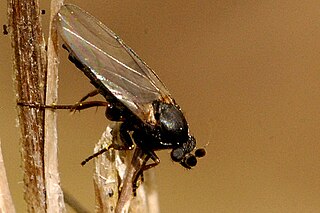
The Phoridae are a family of small, hump-backed flies resembling fruit flies. Phorid flies can often be identified by their escape habit of running rapidly across a surface rather than taking flight. This behaviour is a source of one of their alternate names, scuttle fly. Another vernacular name, coffin fly, refers to Conicera tibialis. About 4,000 species are known in 230 genera. The most well-known species is cosmopolitan Megaselia scalaris. At 0.4 mm in length, the world's smallest fly is the phorid Euryplatea nanaknihali.

The Metopininae are a subfamily of flies in the family Phoridae.

Anevrina is a genus of phorid flies circumscribed by the Italian naturalist Paolo Lioy in 1864.

Phalacrotophora is a genus of scuttle flies. There are at least 50 described species in Phalacrotophora.
Lecanocerus is a genus of scuttle flies. There is at least one described species in Lecanocerus, L. compressiceps.
Apocephalus coquilletti is a species of scuttle flies. It has been witnessed attacking ants of the genus Camponotus.

Apocephalus paraponerae is a species of fly in the family Phoridae discovered by Borgmeier in 1958. This species is a parasitoid of the giant tropical ant Paraponera clavata and uses both visual and chemical cues to locate its host. A. paraponerae can locate fighting or injured ants through host-produced alarm pheromones. Female flies are attracted to the ant to feed and oviposit, while males are attracted to feed and locate females for mating. There is some evidence that suggests that A. paraponerae is a cryptic species complex of at least four genetically distinct species.
Beckerina is a genus of flies in the family Phoridae.

The Metopininae is a tribe of flies in the family Phoridae.
Chonocephalus is a genus of flies in the family Phoridae.
Cremersia is a genus of flies in the family Phoridae.
Diocophora is a genus of flies in the family Phoridae.
Menozziola is a genus of flies in the family Phoridae.
Microselia is a genus of flies in the family Phoridae.
Physoptera is a genus of flies in the family Phoridae.
Rhyncophoromyia is a genus of flies in the family Phoridae.
Xanionotum is a genus of flies in the family Phoridae.

Aenigmatias is a genus of flies in the family Phoridae.






